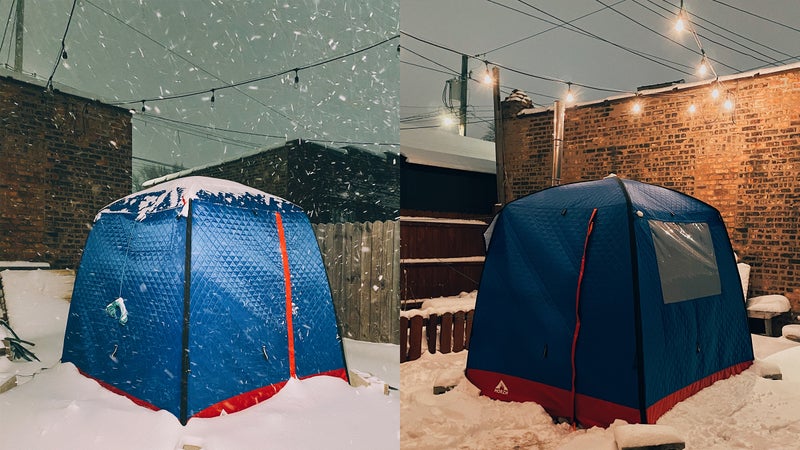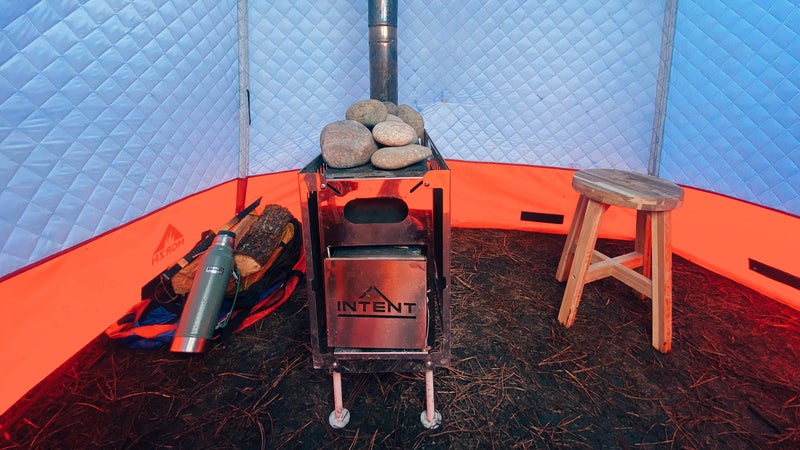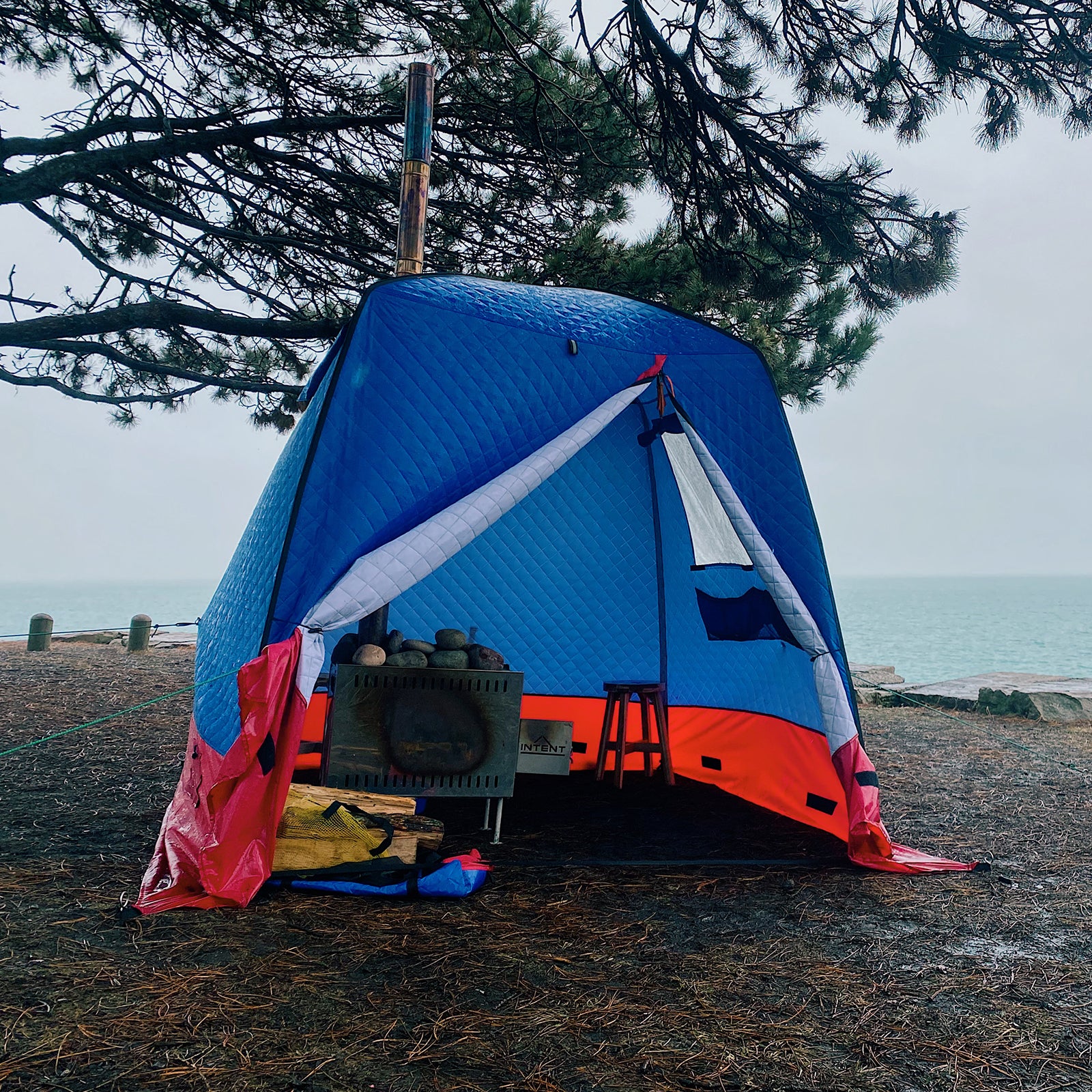For thousands of years, cultures around the world have engaged in the time-honored ritual of sweating it out. Ancient Romans had baths. Russians have banyas, the Japanese have communal sentōs, the Turks have steamy hammams, and the Finns have dry saunas. It’s the latter style, the wood-fired schvitz, whose popularity has been heating up over the past few years and has hit new highs in the United States this dark winter.
Since 2016, sales of in-home saunas have been growing by double digits, according to Mark Raisanen, general manager of Finnleo, North America’s largest supplier of saunas. In 2020 alone, that growth doubled year over year. “For folks who enjoy hiking, camping, biking, and simply being outside, having the chance to complete those activities with a sauna—there’s nothing better,” Raisanen says. But with an entry price of $4,000 for a traditional wood-clad hot room—some skyrocket past $20,000, depending on extras—it raises the question: what kind of options exist for those who may not have the budget or space for something permanent?
Enter the tent sauna. Two Russian brands—Morzh and Mobiba—offer sub-$1,000 systems that feature wood-burning stoves and insulated tents that are packable, portable, and capable of generating scorching temps in excess of 200 degrees. Savotta, a supplier of tents and backpacks to the Finnish military, also serves the European market.
Traditionalists may scoff. But in his 1978 book, How to Build a Sauna, which memorialized the 1970s wave of American interest in Finnish culture, Carlton Hollander put it this way: “The basic purpose of a sauna is to cleanse the body through perspiration. This means opening the pores of the skin and flushing out the impurities in the body through the process of sweating. Any structure or environment that has the ability to achieve that end will suffice as a sauna.” It’s worth noting that the liver and kidneys remove far more toxins in the body than sweat glands, as the New York Times explained in 2017.
“The basic purpose of a sauna is to cleanse the body through perspiration…Any structure or environment that has the ability to achieve that end will suffice as a sauna.” —Carlton Hollander, author of ‘How to Build a Sauna’
These new tent options go far beyond being a cheap, makeshift solution. “People have been finding health solutions in pragmatic ways around the world for centuries, and tents can be a cutting-edge part of that tradition,” says John Pederson, founder of the 612 Sauna Society, a mobile sauna community, and co-founder of Stokeyard Outfitters, which has hosted mobile and tent sauna experiences throughout Minneapolis since 2017.
Pederson explains that thermic bathing practices have evolved to fit the available resources of diverse places and eras: from earthen temazcals in Mesoamerica to the spiritual sweat lodges of the Cherokee and Chickasaw to permanent outbuildings in Finland, where cedar and birch are plentiful. “When I think of an authentic sauna, I think of people solving the problem of how to get the best hot-cold experience in the environment that’s available to them,” Pederson says. “Suddenly, you can take your tent with you, and it can be part of moments that it couldn’t before because of logistics. Imagine having a sauna experience on a road trip with people you love.”

While some may think of winter as the ideal season for a sauna experience, new research proves what many aficionados have known from experience: sweating is good for mind and body year-round. In 2018, Dr. Jari Laukkanen, a cardiologist at the University of Eastern Finland, published a paper in Mayo Clinic Proceedings based on 70 peer-reviewed studies that examined the health benefits of yearlong thermic bathing on more than 2,300 men older than 20. The results: frequent sauna sessions between 176 degrees and 212 degrees Fahrenheit, paired with cold exposure, noticeably lower the risk of cardiovascular disease, dementia, and Alzheimer’s.
The key is in the generation of lämpömassa, the heat created from raising your core temperature, says Glenn Auerbach, publisher of the Sauna Times and president of the Sauna Research Institute, which counts Laukkanen among its board of directors. “Good heat is what good sauna is all about, and a tent sauna can provide it,” he says. “When you consider the cost, portability, and the ability to deploy into nature, it’s a game changer.” For Auerbach, infrared saunas, which use light to generate heat, represent bad heat because they’re not warming the environment around the body.
I wanted to experience this new wave of portable saunas, so I reached out to Morzh, which sent a sample from Yekaerinburg, Russia, in just under a week. Mobiba, based in southern Siberia, has an authorized U.S. retailer that reported models have been flying off the shelves of its Los Angeles warehouse too fast to keep in stock (and are currently on backorder). Here are the Morzh specs:
- Price: Starts at $659, with optional add-ons, including a rock holder ($18), water tank for steam ($105), and a stove mitten ($4)
- Tent and poles weight: 18.3 pounds
- Stove weight: 37.9 pounds
Named after the Russian word for “walrus,” the Morzh system features a quilted tent made with three layers of flame-resistant oxford cloth. Two aircraft-grade aluminum-alloy poles zip into channels on the outside of the tent, giving the structure its shape. Morzh also sells an optional waterproof floor ($160), which provides noticeable insulation against the chill of the ground.
Throughout my testing, the tent withstood a Chicago blizzard that dumped snow over three weeks. I also hiked the setup—including tent, stove, stools, and rocks—to a perch overlooking Lake Michigan, where I cranked up the heat and spent three hours alternating between sitting in the heat, swimming in 34-degree water, and sipping homemade broth from a Stanley thermos.

The stove is made from eight-millimeter AISI 430 stainless steel and occupies about a quarter of the tent to the left of the door. Six chimney sections collapse and fit inside the stove when not in use, along with the legs, which screw into the bottom and raise the unit off the floor. When assembled, the chimney exits the tent through a steel grommet that protects the exterior fabric from coming into direct contact with the stove. The tent fits three people comfortably but could stretch to accommodate four or five.
On one of the coldest days of the blizzard, when it dropped to -6 degrees and the windchill crept to negative double digits, I started to sweat about ten minutes after lighting the fire. Before it had been a half-hour, the ambient temperature hit 200 degrees, according to an oven thermometer I hung from one of the D rings.
While the temperature inside the tent can swing depending on how much you’re coming in and out—and how diligently you tend the fire—the key is stacking granite rocks on top of the stove to capture heat and keep the space warm for a longer period of time. I didn’t find the optional rock holder particularly helpful, because it piled the rocks in three or four layers and minimized the surface area in direct contact with the stove. A shallower layer of rocks heated faster and produced better löyly (the Finnish word for the steam that envelopes you after you ladle water onto the hot stones).
One minor complaint I had is that some of the fasteners, which allow convection screens on the sides of the stove to collapse or fold out for better airflow, came apart. It was a small inconvenience, but they were easily replaced with a few machine screws and nuts.
All told, seven forearm-sized pieces of wood kept the temperature between 180 and 215 degrees for more than two hours. That’s about the number of split logs in a ready-to-burn bundle available at most big-box stores. Cooling everything down is as simple as unzipping one of the vents in the side wall or rolling up the door flaps. In less than an hour, the rocks are ready to take home. If you’re camping out, the tent makes a suitable overnight shelter.
While the Morzh may be best used for car camping, it is what it claims to be: a truly portable wood-fired sauna that will have the sweat beading from your brow—ideally within cannonball range of a lake in snow-covered woods.
A tent sauna isn’t without trade-offs. You’re not getting the hygge that comes from the cedar aroma and soft electric lights inside a permanent structure. Without raised seating, your feet might feel a little cooler than the rest of your body if they’re resting on the ground. But this is something different: an option for adventurers who want to take their heat with them, whether that’s to set up next to a body of water or on top of a mountain.


